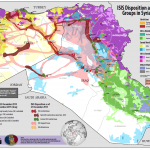
A map from February 2016 depicting various ethnic groups in Iraq and Syria throughout the region controlled by the Islamic State of Iraq and the Levant (ISIL).
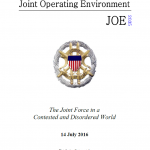
The Joint Operating Environment 2035 (JOE 2035) is designed to encourage the purposeful preparation of the Joint Force to effectively protect the United States, its interests, and its allies in 2035. For the Joint Force, thinking through the most important conditions in a changing world can mean the difference between victory and defeat, success and failure, and the needless expenditure of human lives and national treasure versus the judicious and prudent application of both to defend our vital interests.
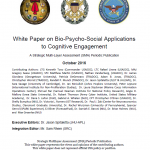
The underlying concept of this paper is how bio-psycho-social approaches to cognitive engagement, described in greater depth by DeGennaro, may be put to use to collect, analyze, and/or apply information to meet a tactical, operational, or strategic end. This White Paper will focus on the proverbial “rubber meets the road” approaches of behavioral operations in the human domain where the former is “the study of attributes of human behavior and cognition that impact the design, management, and improvement of operating systems, and the study of the interaction between such attributes and operating systems and processes” and the latter is “the presence, activities (including transactions both physical and virtual), culture, social structure/organization, networks and relationships, motivation, intent, vulnerabilities, and capabilities of humans (single or groups) across all domains of the operational environment (Space, Air, Maritime, Ground, and Cyber).” Information Operations (IO) doctrine defines the cognitive domain as the component of the information environment (IE) that encompasses the gray matter of those who transmit, receive, and act upon information. Cognitive operations such as information processing, perception, judgment, and decision-making are the most vital aspect of the IE. Cognition is influenced by individual and cultural beliefs, norms, vulnerabilities, motivations, emotions, experiences, morals, education, mental health, identities, and ideologies and thus requires research and analysis methods from the bio-psycho-social sciences to understand and manipulate. When, how, and most importantly why to apply that understanding to US advantage at the tactical, operational, and strategic level is the focus of this effort.
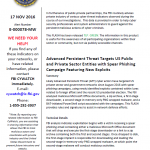
Likely Advanced Persistent Threat (APT) cyber actors have targeted US private sector and government networks since August 2016 with spear phishing campaigns, using newly identified exploits contained within lures related to foreign affairs and the recent US presidential election. The FBI analyzed malicious Microsoft Office documents, a zip archive, a first-stage downloader, a second-stage in-memory-only PNG wrapped malware, and a BAT-initiated PowerShell script associated with the campaigns. This FLASH provides rules and signatures to assist in network defense efforts.
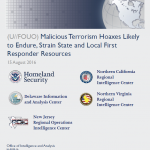
This Reference Aid is intended to provide information on malicious terrorism hoaxes that will continue to challenge first responder resources throughout the Homeland and territories. This Reference Aid is provided by I&A, DIAC, NCRIC, NVRIC, and NJ-ROIC to support their respective activities, to provide situational awareness, and to assist federal, state, local, tribal, and territorial government counterterrorism and law enforcement officials and first responders with recognizing the indicators and implications of malicious terrorism hoaxes. The use of hoax calls may also be used as a technique to lure authorities to a particular location for the purpose of conducting a potential attack, but is not discussed in this article, as luring is viewed as its own distinct tactic.
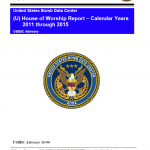
This report serves to present information and analysis associated with fire, arson, and bombing incidents at houses of worship (HOWs) occurring within the United States for the past 5 years, between January 2011 through December 2015, and reported to the Bureau of Alcohol, Tobacco, Firearms and Explosives (ATF). In total, there were 733 fire and explosion related incidents, per ATF reporting, for all 50 States. The information contained herein does not represent all fire, arson and bombing incidents for the United States. This report only represents those incidents that have been reported to and investigated by ATF.
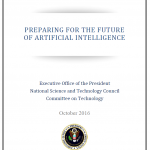
AI has applications in many products, such as cars and aircraft, which are subject to regulation designed to protect the public from harm and ensure fairness in economic competition. How will the incorporation of AI into these products affect the relevant regulatory approaches? In general, the approach to regulation of AI-enabled products to protect public safety should be informed by assessment of the aspects of risk that the addition of AI may reduce alongside the aspects of risk that it may increase. If a risk falls within the bounds of an existing regulatory regime, moreover, the policy discussion should start by considering whether the existing regulations already adequately address the risk, or whether they need to be adapted to the addition of AI. Also, where regulatory responses to the addition of AI threaten to increase the cost of compliance, or slow the development or adoption of beneficial innovations, policymakers should consider how those responses could be adjusted to lower costs and barriers to innovation without adversely impacting safety or market fairness.
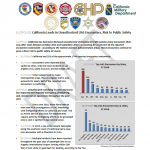
California has had more disclosed unauthorized Unmanned Aircraft Systems (UAS) encounters than any other state between October 2015 and September 2016—accounting for 21 percent of the reported encounters nationwide—according to the Federal Aviation Administration (FAA). These encounters continue to pose a direct risk to public safety air assets.
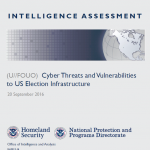
DHS has no indication that adversaries or criminals are planning cyber operations against US election infrastructure that would change the outcome of the coming US election. Multiple checks and redundancies in US election infrastructure—including diversity of systems, non-Internet connected voting machines, pre-election testing, and processes for media, campaign, and election officials to check, audit, and validate results—make it likely that cyber manipulation of US election systems intended to change the outcome of a national election would be detected.
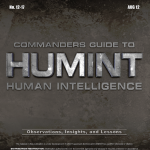
Army commanders rely upon timely, relevant, and accurate combat information and intelligence in order to successfully plan, prepare, and execute operations. Human intelligence (HUMINT) and counterintelligence (CI) are two critical assets commanders have, either organic to their unit’s table of organization and equipment (TOE) or through attachment from a supporting command, which can provide input to both combat information and intelligence. While there are similarities between the methodology and tactics, techniques, and procedures (TTP) used by HUMINT and CI, their training and missions are separate and distinct.
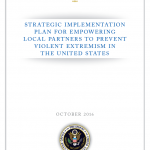
In 2011, the United States adopted the Strategy for Empowering Local Partners to Prevent Violent Extremism in the United States (Strategy) and a corresponding Strategic Implementation Plan. Since publication, the mission to prevent violent extremism has progressed, and violent extremist threats have continued to evolve. The overall goal of the Strategy and United States Government efforts to implement it remains unchanged: to prevent violent extremists and their supporters from inspiring, radicalizing, financing, or recruiting individuals or groups in the United States to commit acts of violence. This updated Strategic Implementation Plan responds to the current dynamics of violent extremism and reflects experiences and knowledge acquired over the last five years. It replaces the 2011 Strategic Implementation Plan for Empowering Local Partners to Prevent Violent Extremism in the United States.
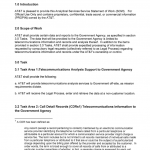
AT&T shall provide certain data and reports to the Government Agency, as specified in section 3.0 Tasks. The data that will be provided to the Government Agency is limited to telecommunications information and records and analysis thereof. In addition to the items provided in section 3.0 Tasks, AT&T shall provide expedited processing of information requested by compulsory legal requests (collectively referred to as Legal Process) regarding telecommunications information and records under the AT&T’s ownership or control.
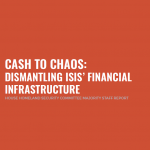
Despite battlefield losses, ISIS continues to operate its own terrorist pseudostate and claims a growing global footprint. At least 34 radical Islamist groups have pledged their allegiance to ISIS. As of this printing, the organization has managed to expand its presence to dozens of countries and territories—in addition to recruiting tens of thousands of fighters from over 120 nations. Most alarmingly, ISIS is driving an unprecedented surge of terror plots against the West and poses a persistent and grave threat to the U.S. homeland.
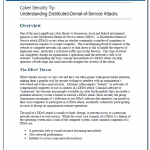
One of the most significant cyber threats to businesses, local and federal government agencies is the Distributed-Denial-of-Service attack (DDoS). A Distributed Denial of Service attack (DDoS) occurs when an attacker commands a number of computers to send numerous requests to a target computer. The overwhelming flood of requests to the website or computer network can cause it to shut down or fail to handle the requests of legitimate users, much like a rush hour traffic jam on the freeway. This type of attack can completely disrupt an organization’s operations until the network is able to be restored. Understanding the basic concept and methods of a DDoS attack can help operators of both large and small networks mitigate the severity of the attack.
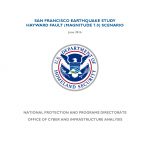
The results of this analysis show a strong earthquake will likely cause significant damage to critical infrastructure in the area affecting 547 dams or water control structures, render approximately 300 roadway segments unusable, and cause damage to 172 water and wastewater treatment systems. The scenario earthquake will likely cause damage to 154 dams in the area. Seven of the dams will likely experience Extensive or Complete damage. The Ward Creek Dam, which is used for flood control, is likely to incur Complete damage. Extensive damage to the James H. Turner Dam poses the greatest risk to downstream population. The earthquake will cause damages to many road segments, bridges, and tunnels in the area. As a result, travel times on these roadways and others will increase significantly. Multiple areas on freeways such as I–680, I–880, and I–580 will have the highest above normal traffic volumes. Several bridges on these freeways will also likely incur Extensive damage. Tunnels in the area will likely have less damage with bores in the Caldecott Tunnel on State Route 24 experiencing only Moderate damage.
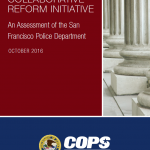
As a result of an extensive independent assessment of the San Francisco Police Department’s (SFPD) activities and operations, the U.S. Department of Justice (DOJ) Office of Community Oriented Policing Services (COPS Office) presents findings and recommendations on how to address the agency’s needs proactively in a long-term manner to improve trust between the SFPD and the communities it serves.
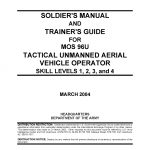
This manual identifies the individual MOS training requirements for soldiers in MOS 96U. Commanders, trainers, and soldiers should use it to plan, conduct, and evaluate individual training in their unit. This manual is the primary MOS reference to support the self-development and training of every 96U soldier.
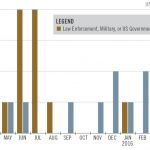
A joint intelligence bulletin issued in late August by the Department of Homeland Security, FBI, and National Counterterrorism Center (NCTC) assesses that homegrown violent extremists (HVEs) are “increasingly favoring civilian targets” as opposed to government facilities and personnel. Previous assessments have found that HVEs are most likely to prioritize “law enforcement personnel, military members, and US Government-associated targets.” However, a recent shift towards civilian targets has likely been driven by the accessibility of “soft targets” that are less secure and provide greater opportunities for mass casualty attacks.
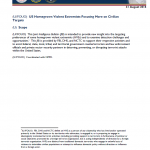
This Joint Intelligence Bulletin (JIB) is intended to provide new insight into the targeting preferences of some homegrown violent extremists (HVEs) and to examine detection challenges and opportunities. This JIB is provided by FBI, DHS, and NCTC to support their respective activities and to assist federal, state, local, tribal, and territorial government counterterrorism and law enforcement officials and private sector security partners in deterring, preventing, or disrupting terrorist attacks within the United States.
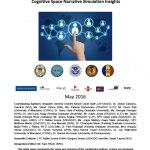
When planning to deal with any adversary or potential adversaries, it is essential to understand who they are, how they function, their strengths and vulnerabilities, and why they oppose us. Events over the course of the last year and a half highlight the importance of those factors as they relate to the Islamic State of Iraq and the Levant (ISIL or Da’esh). One of Da’esh’s obvious strengths is its ability to propagate tailored messages that resonate with its audiences. If the US Government and our allies are to counter Da’esh effectively, we must attack this center of gravity.